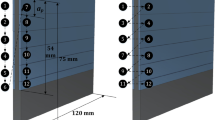Abstract
An enhanced simulation model is presented in this paper to predict form deviations in end milling processes of thin-walled structures. The calculation of tool engagement is based on level curves representing surface geometry of the workpiece and the NC code driven sweep volume. To consider influences of force-induced deflections resulting in static form errors on machined surface of the workpiece, a model for superposed stresses is enclosed. Derived from the tool engagement, the cutting force is predicted using a parametric force model. The experimental investigations within the measuring of static and dynamic form errors during processing and afterwards are shown and measurement results are compared with results of the cutting simulation to verify the proposed method. The presented achievements are deduced from research activities aiming at an increased understanding of shape deviation induced by interactions between tool, workpiece and clamping device during machining.









Similar content being viewed by others
References
Altintas Y (2000) Manufacturing automation (metal cutting mechanics, machine tool vibrations, and CNC design), Cambridge University Press, Cambridge
Denkena B, Tracht K, Schmidt C (2006) A flexible force model for predicting cutting forces in end milling, Prod Eng XIII (2)
Denkena B, Rehling S, Tracht K (2004) Multidisciplinary simulation of manufacturing systems and processes. In: 37th CIRP international seminar on manufacturing systems, pp 43–46
Ratchev S (2004) Milling error prediction and compensation in machining of low-rigidity parts. Int J Mach Tools Manuf 44:1620–1641
Schmidt C (2006) Level curve based geometry representation for cutting force prediction. In: 17th DAAAM international symposium
Schneider PJ, Eberly DH (2003) Geometric tools for computer graphics, Morgan Kaufmann, USA
Wan M (2005) Numerical prediction of static form errors in peripheral milling of thin-walled workpieces with irregular meshes. ASME J Manuf Sci Eng 127:13–22
Acknowledgement
The CRC653/K2 is funded by the Deutsche Forschungsgemeinschaft (DFG). The Institute of Production Engineering and Machine Tools (IFW) is partner of the EU-funded FP6 Innovative Production Machines and Systems (I*PROMS) Network of Excellence (http://www.iproms.org). The authors would like to express their thanks to the anonymous reviewers, whose constructive suggestions have improved the quality of this paper. We thank Ms. Christine Yang and Ms. Rachelle Barr also for their kind help.
Author information
Authors and Affiliations
Corresponding author
Rights and permissions
About this article
Cite this article
Denkena, B., Schmidt, C. Experimental investigation and simulation of machining thin-walled workpieces. Prod. Eng. Res. Devel. 1, 343–350 (2007). https://doi.org/10.1007/s11740-007-0017-9
Received:
Accepted:
Published:
Issue Date:
DOI: https://doi.org/10.1007/s11740-007-0017-9




